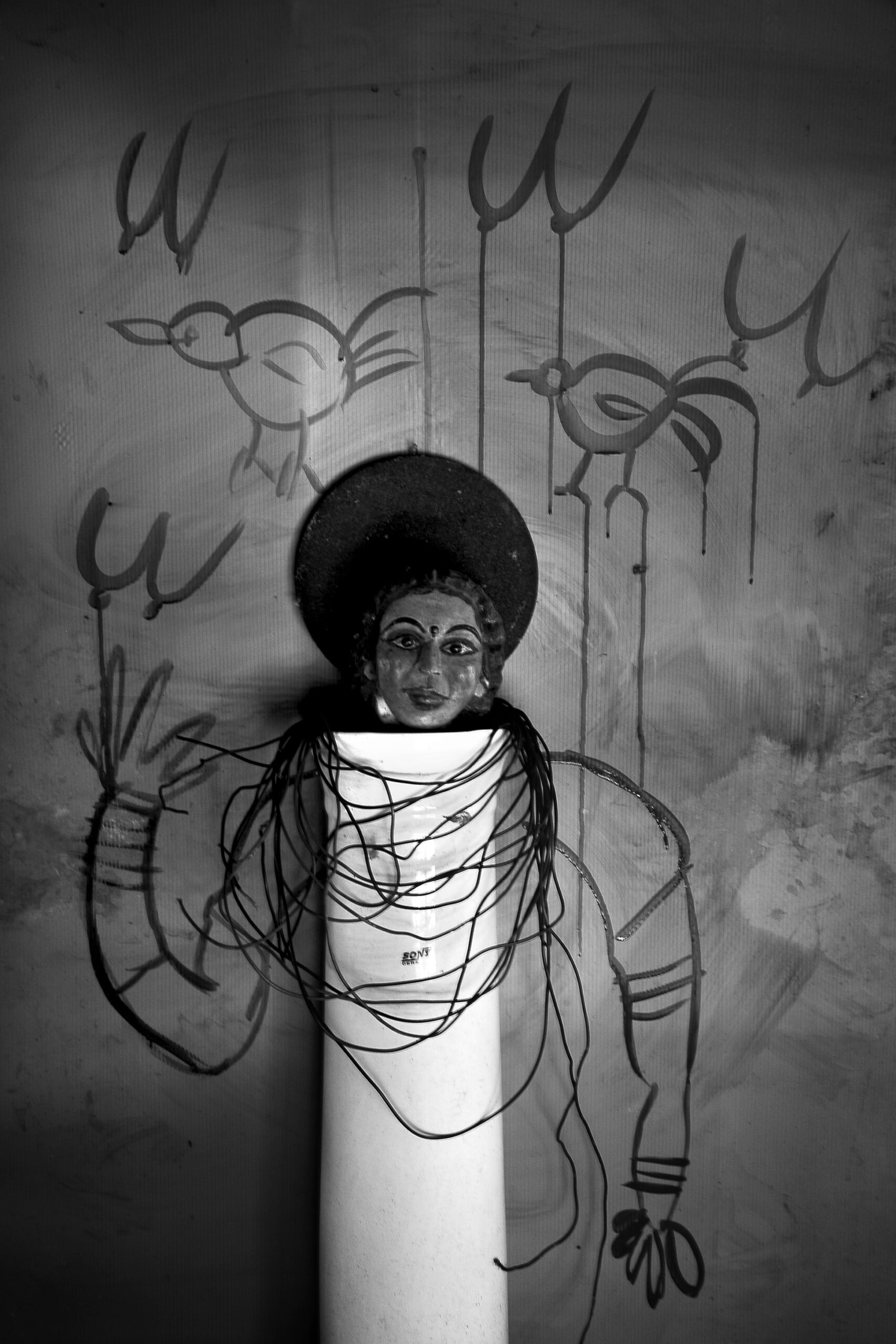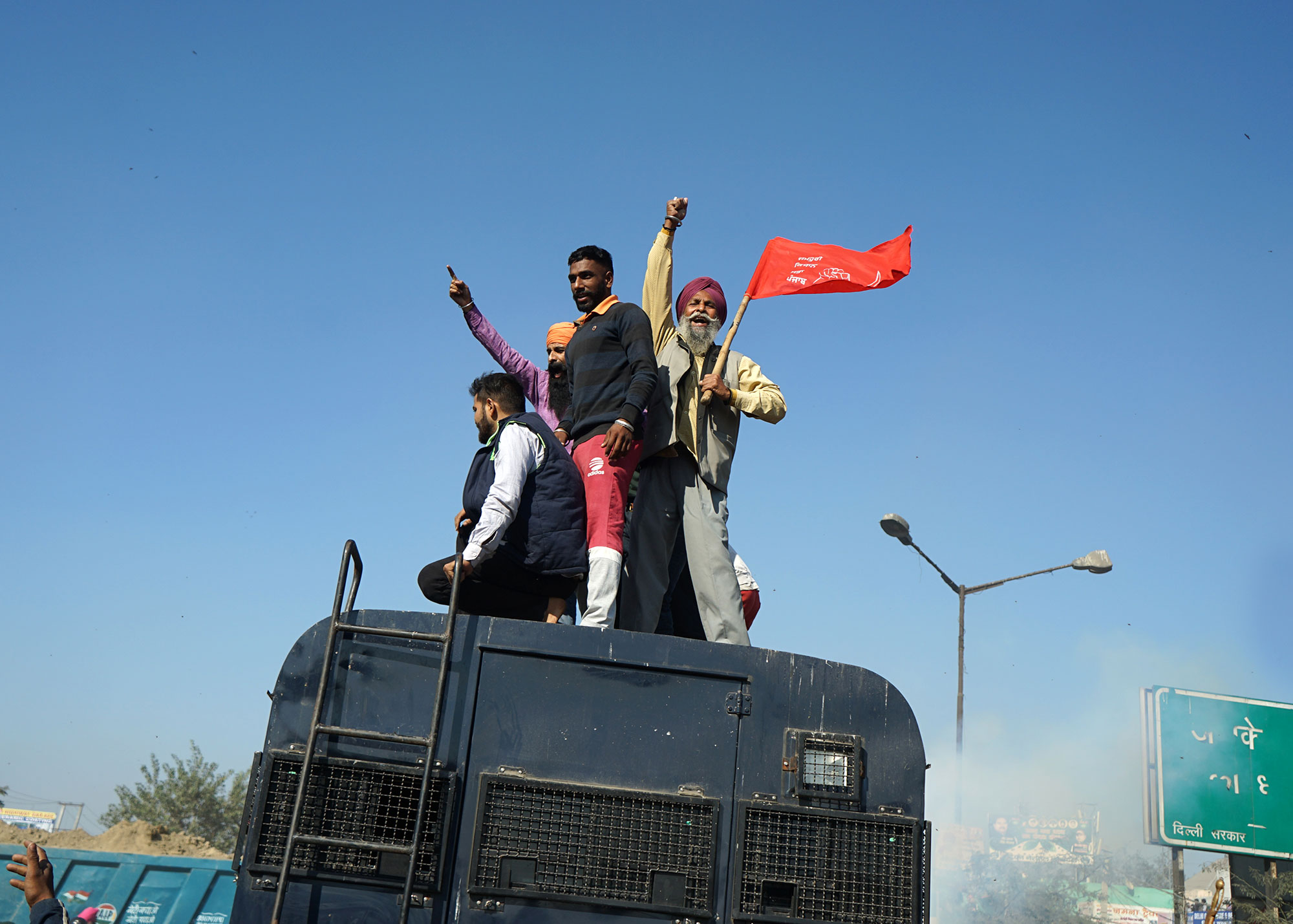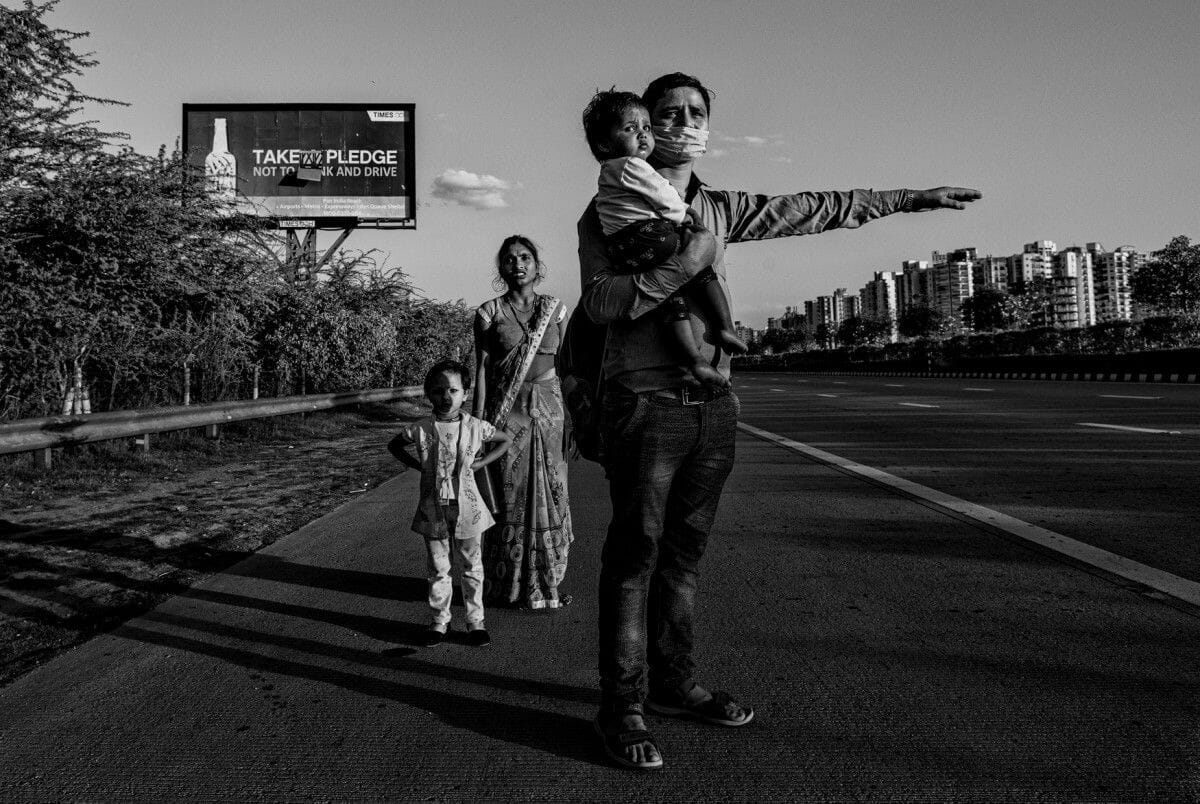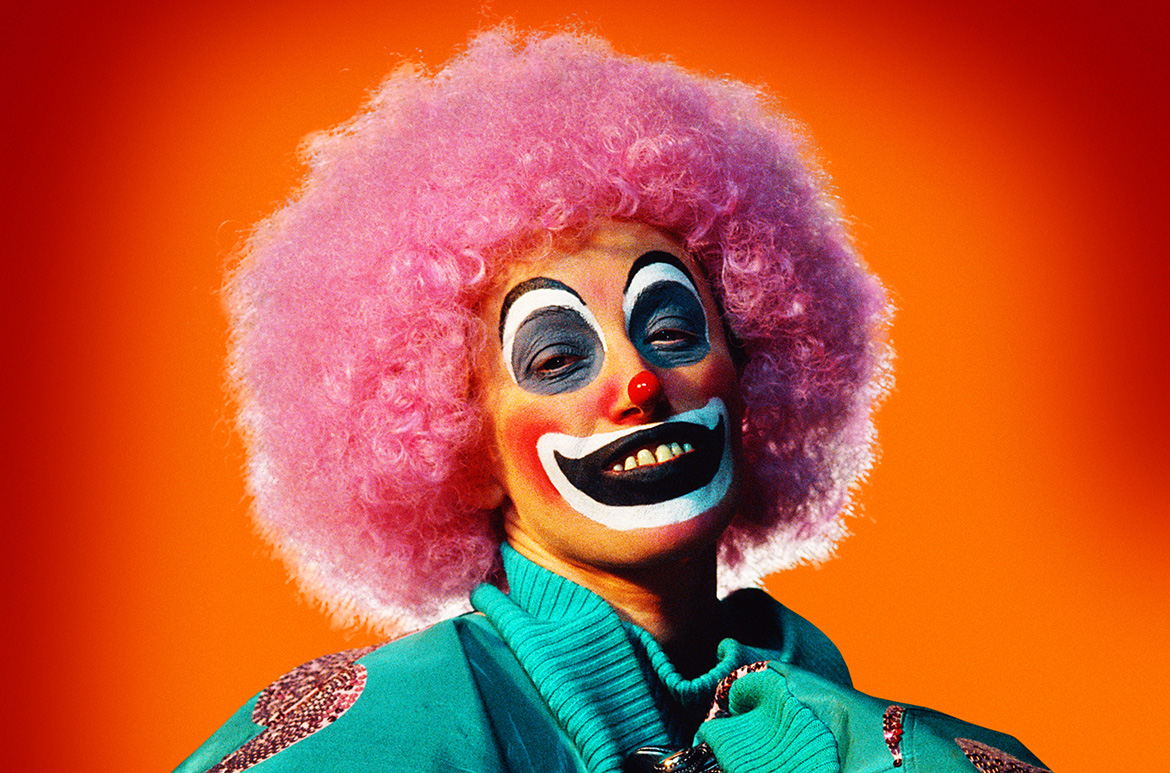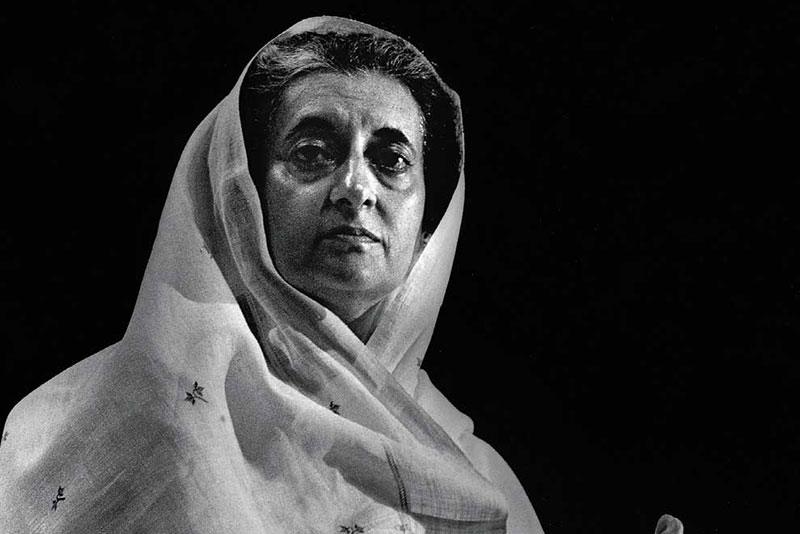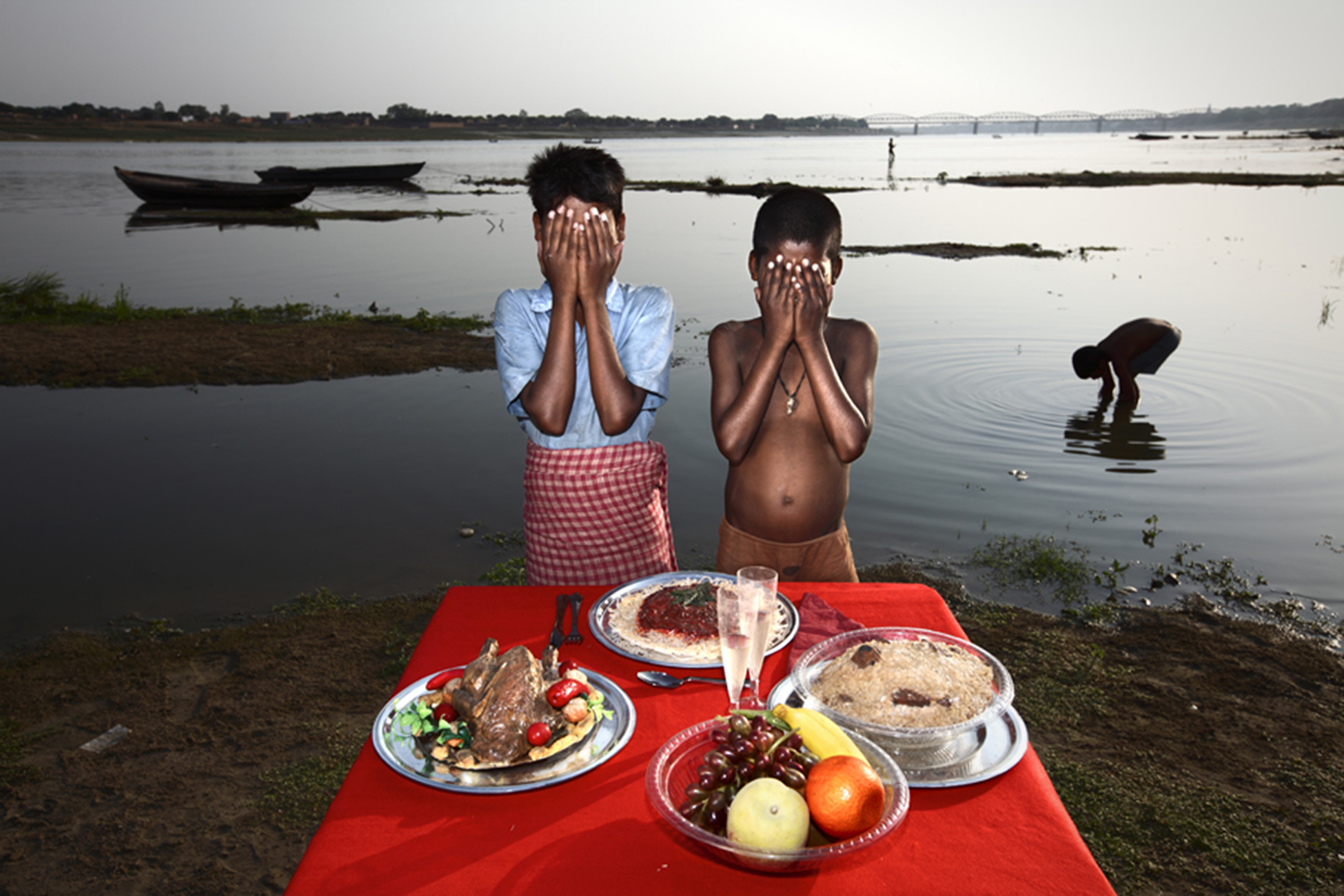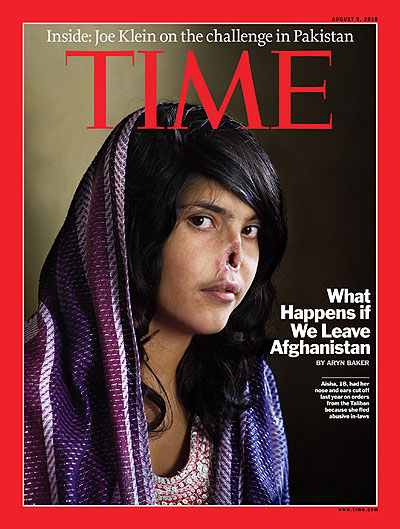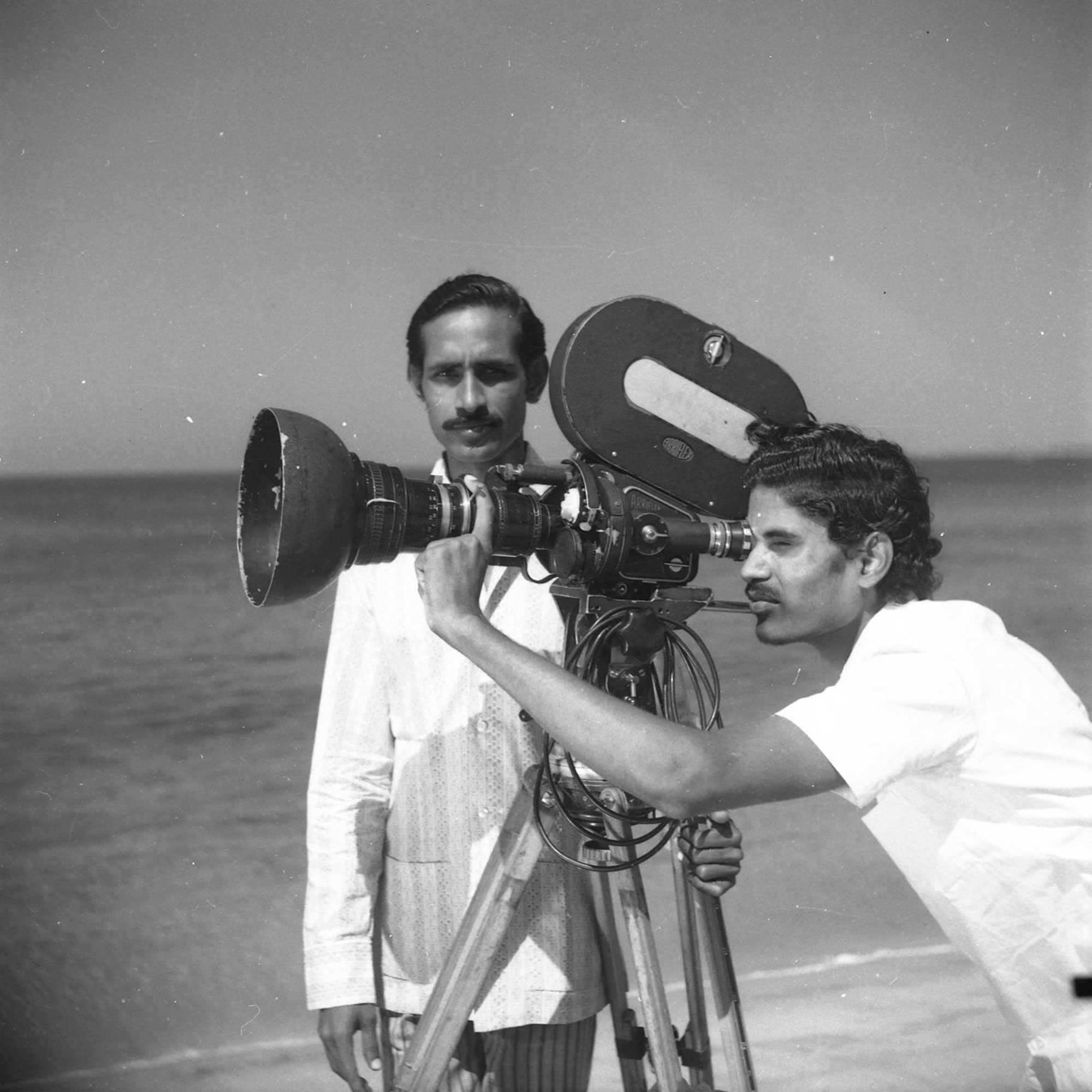Focus
Reflections
Photo Mail focuses on
Contemporary
Photography Practitioners
Their works and
Its aesthetics
In the broader
context of
Photographic theory
and
Philosophy
This Editorial article
analyses portraits of
four spiritual
and political leaders
Shot by Ace Indian
photographer
Raghu Rai
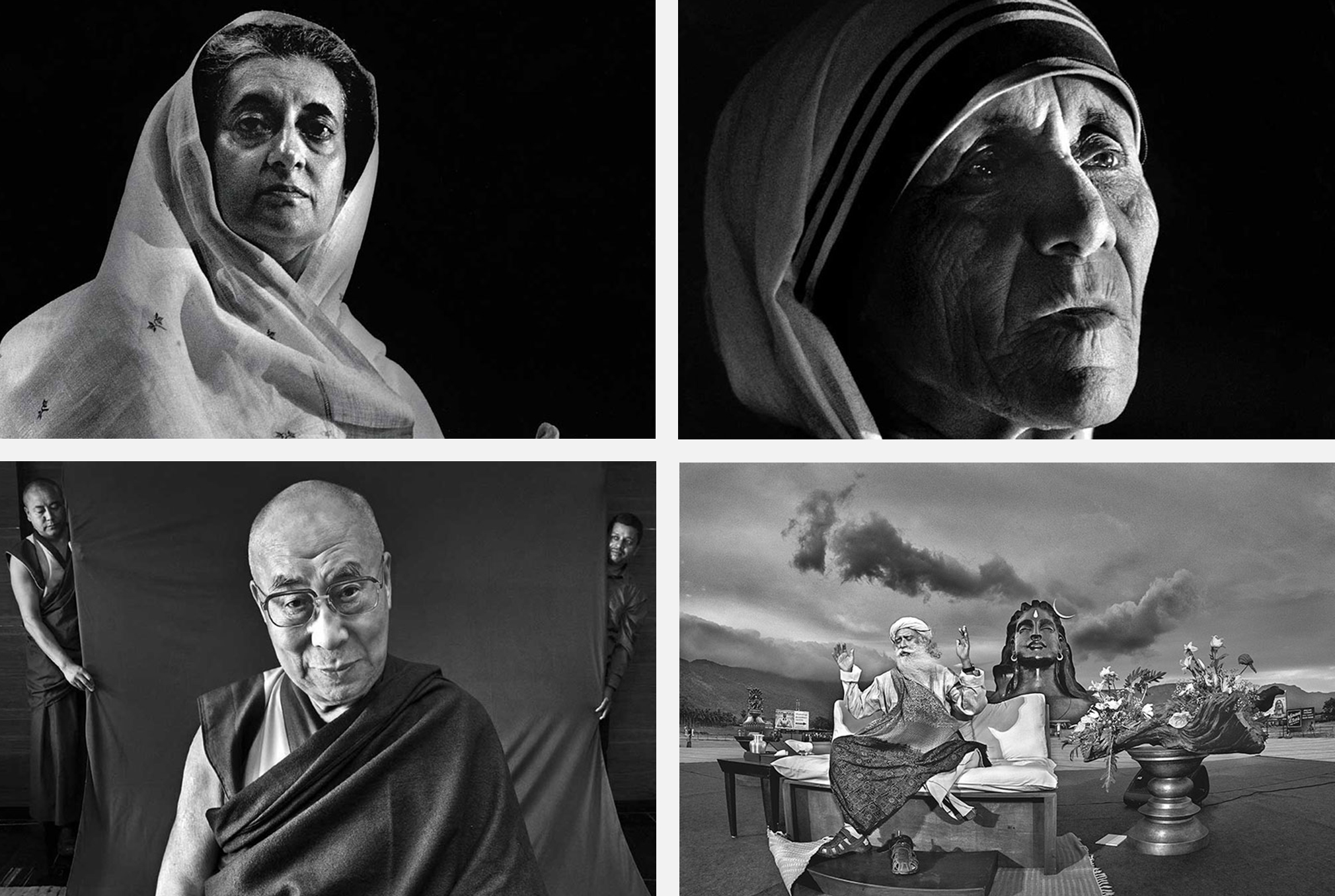
Indira Gandhi, Mother Teresa, Dalai Lama and Jaggi Vasudev © Raghu Rai | Source Internet
Iconic Faces
Zooming into Raghu Rai’s Photographic Practice
Padma Shri Raghunath Rai Chowdhry, better known as Raghu Rai, was born in 1942, in Jhang, Punjab, then part of British India and now in Pakistan. His elder brother, S Paul (Sharampal Chowdhry), initiated him into the craft of photography, and he entered the field in 1965, making a name for himself during a 10 year tenure with The Statesman, starting in 1966. He was awarded Padma Shri in 1972, a reflection of the rapid acceptance he has had. Later, he served as the director of photography at India Today for another 10 years, starting from 1982 to 1992. The six years between his departure from The Statesman and his arrival at India Today was spent as a freelance photographer, but his work remained very much photojournalistic. Henri Cartier-Bresson nominated Rai to join Magnum Photos in 1977; and both the individual’s and the organization’s influence can be seen throughout Rai’s work. Aesthetically and, by extension, politically, there is little to separate Raghu Rai from the ideology of Magnum Photos. It should also be remembered that the whole of photojournalism (or even the whole of journalism) has always adopted the formats and methods of European and American publications, and have catered to largely liberal values – with the exception of mouthpiece publications of politically committed organizations, but it can be seen that the formats and aesthetics used by these publications rarely varied, especially with respect to photojournalism. A broad observation that can be made is that photojournalism has remained individualist in conception, privileging the notions of Truth and Human Rights, and making statements using these notions as facades; Raghu Rai’s (and Magnum’s, although it is no longer really just a photojournalists’ organization) work is no different.
Some of the most recognizably Indian things have been etched into the social memory as photographs of Raghu Rai – Khajuraho, Mumbai, Kolkata, Varanasi, the Bhopal gas tragedy, and not to mention the idea of India itself (to pick only a few from his most popular works); five among these are built on geographic stereotypes and preconceptions which are illustrated through his photographs, and the gas tragedy is one of those tragic events whose photographic coverage gets its status because the images ended up being reminders of a horror. Raghu Rai’s photos, beyond the formal brilliance that they possess, can be summed up in such descriptions. It is not at all reductive to say that, for example, most of Rai’s iconic images have the Indian crowd as the subject, presented with the wonder of a foreigner who looks at the crammed Indian cities. Such simple and easily identifiable ideas communicated through a photographic language built on tension and graphic quality have helped to make him arguably the most popular Indian photographer of all time.
Having become a patriarch figure in Indian photography through decades of excellence, he now commands the viewers’ attention towards whatever subject he picks. It is because of his stature that Indira Gandhi, Mother Teresa, Dalai Lama, and Jaggi Vasudev now have a common feature; that they have been photographed by Raghu Rai. It is interesting that if even one is removed from these four personalities, the ideology that will be attributed to the photographer will be seen to change – without Indira Gandhi, it becomes blindly religious; without Mother Teresa, it becomes a glorification of the Indian spirituality; without Dalai Lama, it becomes a pandering to the changing governments; and finally, without Jaggi Vasudev, it was admiration of politically acceptable leaders. All of these readings are partially true, and must be taken into consideration, but there is a need to revisit the Rai’s photographs of the other personalities, and see them in the context of his coverage of Jaggi Vasudev.
The true position of the photographic images in society can be understood by examining the status that Rai’s images have attained; his photographs of Mrs. Gandhi illustrate what the people then (and her supporters even today) found to be her most amazing, and most defining, feature – that she was a (upper-class and upper-caste) woman who overpowered men, the new female ideal who was strong and imposing, unlike the traditionalist ideal of a housewife. This mother figure that Mrs. Gandhi came to represent was also the mother of the emergency rule, and who, towards the end of her life, became more and more insecure about her power; but none of her photographs, including those by Rai, betray any of this. She is always the strong woman with a straight back, a piercing look, and a serene smile in all the images, with the effects of personal and political turbulence understandably not allowed to be shown; many authoritarian leaders in history have been known to censor such depictions so that their followers do not lose heart. The argument against this claim that Rai gave Indira Gandhi an exalted status can be made by pointing to the various “mundane” activities of Indira Gandhi that has been captured; but this argument undermines itself, precisely because all the images of Indira Gandhi, not just Rai’s but anybody else’s, presupposes the matriarchal status of the lady – one needs to only look at that famous photo of Indira Gandhi and Sonia Gandhi with the young Priyanka and Rahul, and it is clear that the image is not about just any rich family, but it is the ideal family of the ruler. The benevolent gaze of Indira Gandhi, a substitute for the usual patriarchal gaze that is depicted in such images, confirms this.
Nor can Rai’s approach to Indira Gandhi be termed especially unique, even if we consider the Indian subcontinent alone. Photographs of Mahatma Gandhi and Jawaharlal Nehru depict them going about their daily activities, again presupposing their exalted status. The scenario has seemingly changed quite a bit, gradually, since Rajiv Gandhi’s assassination; today, the images of Narendra Modi or of Manmohan Singh that we see continue to conform to ideas about them (Manmohan Singh is rarely photographed while he is speaking, and Modi is depicted either in an awkward and comical posture, or an energetic and powerful speaker, depending on which political opinion is to be illustrated), but they are rarely about the daily lives of these leaders – the wall of (photographic) images erected around the leaders are comprised of staged scenarios and controlled dissemination of information. Yet, Rai’s images themselves came close to the images of our contemporary leaders, because he understood the power of photographs in reinforcing, and imposing, ideas. Speaking about his photographs of Indira Gandhi, which he created over a long period, he says, “When I started doing this, I realized that if someone in the future didn’t know who she was, and what a strong personality she was, what a tough leader she proved to be, perhaps they would realize that by looking at these photographs. I began to ask myself, does this picture stand the test of time by itself, for itself?”[1]
This image by image approach, in spite of Rai’s statement, can be more convincingly put down as a result of the demands of photojournalism, especially while covering the activities of someone like the prime minister; usually, only one image gets published alongside an article or feature, and even if multiple images are published, they will have standalone value. The format of photojournalism offers no chance for the photographer to build a narrative through multiple episodes, and demands that the photographer incorporate whatever narrative is needed (or rather, ordered by the editorial) into single images. Just as any top-tier photojournalist who was working in Delhi during Mrs. Gandhi’s rule, Rai also has many of these idolizing images of her, which later came together as a book. How else can Rai be expected to portray Mrs. Gandhi if he wished to keep his job? Of course, this rhetoric about the charismatic leader who will lead the nation into greatness is now being used by groups around the world. In fact, the entirety of history is corrupted by this notion, by which the effort of the masses is erased and the credit for victory is given to the leader alone. Rai’s mode of imagemaking plays to this rhetoric overtly, but it is disguised under hegemonic notions of beauty, just as all propaganda art is. In this respect, it is also equivalent to commercial photography, as it works to establish the ideas of a particular group or institution – the only difference being that the object to be promoted is not a commercial product, but an ideology.
A more classic case of propaganda art among Rai’s works is his portrait (series) of Mother Teresa. Mother Teresa is, for Rai (and later on, for the world), a frail and pious old woman. The Mother Teresa who hailed the Indian Emergency, saying that the people were happy, there were no strikes, and there were more jobs, is tucked safely away from the sight of Rai’s camera; not to mention the atrocious dogma and superstitions that masqueraded as a “love for the poor”, which directly resulted in the glorification of suffering and a denial of proper medical care. The criticisms against Mother Teresa need not be listed here; the only thing that needs to be pointed that is that, in the jargon of today’s capitalist world, she was a PR agent of the MNC that is the Catholic Church. But since she was and is part of a feudal and steadfastly dogmatic world, she is referred to as a saint serving the will of God. Raghu Rai is a disciple of this saint, taking her “high philosophy” to the people through his medium, naively (or cunningly, whichever way one prefers to view it) putting away the material effects of this backward philosophy. He produced four books on Mother Teresa – the first was published in 1996, a year before her death (and nearly thirty years since Rai started photographing her), a second in 2003, the third in 2005 and the fourth in 2017, six months after her canonization by the Vatican as Saint Teresa of Calcutta.[2] Similar was the case with Indira Gandhi, the first book on whom was published during a high period of her government, following the victory in the war of 1971, and the second book was published after her death in 1985. It’s obvious from the publication dates that these books were afterthoughts to his photography assignments, to say the least. In such a series, there’s hardly any space for exploring nuances – each assignment or shoot would have been targeted at getting a specific image or images for immediate publication, and it’s safe to assume that everything shot during the assignment would have been more tailored to fit the editorial view of the publication that it was to appear in – in these cases, mainly The Statesman and India Today.
Neither of these depictions have been challenged significantly since the political climate was favourable for them. Mother Teresa was celebrated because India was “secular”, and Indira Gandhi for being part of the Nehruvian legacy. Here, we see the two central ideas of most national art – India as a pluralistic and tolerant country, and the Nehruvian idea of modernity. Muslim spirituality is not to be promoted according to this notion of India, because Islam is equivalent to Pakistan in the India-Pakistan binary; and sure enough, the one religion that does not have a spiritual leader exalted in Raghu Rai’s work is Islam. Instead, we are treated to the peaceful lives of Muslims in India, quietly reinforcing the benevolence shown to them by the Indian state.
This benevolence of the Indian state runs as a much more subtle theme in Rai’s series of images on the 14th, and current, Dalai Lama, almost existing outside the photographs themselves. “The one who describes himself as ‘just a simple Buddhist monk’ lives in a heavily guarded hilltop compound in the Dharamsala suburb, in India”, says the accompanying text[3] to Rai’s images – the element of irony in this text is not reflected in Rai’s statements on a figure whom he refers to as “His Holiness”. Rai’s book of photographs on Dalai Lama is titled “God in Exile”. Rai also contrasts Dalai Lama, who, it is to be remembered, is also a (spiritual) leader of a country, to Indira Gandhi; he says that while Indira Gandhi becomes a different person during public appearances, “His Holiness remains the same: all-knowing, with gentle sincerity, sensitivity and care for other beings.”[4] Needless to say, Dalai Lama’s political background is entirely erased, and we are left to view the images of a quite funny old man and his own little cult, as he spends his time watching the Mahabharata serial on TV and watering plants, and wonder what sort of harm he could possibly do to anybody. It logically follows that the communist state of China is playing the villain’s role, and India is the protector of this harmless man; who, in truth, has virtual control over a large amount of wealth (by being in a power position with relation to Tibet), who takes political stances[5] and who has ignored the serious allegations of sexual harassment that have arisen against his followers[6]. This series too seems to have been made by selecting images from assignments carried out over many years.[7]
Jaggi is the latest in this line, and Rai’s photographs of him follow the same format as his photographs of the other three personalities; they differ only in specifics, the individual characteristics of each personality. Jaggi comes out in the photographs as an outright showman, the typical 21st century spiritualist with his exaggerations and an ecstatic demeanour. Rai photographed the consecration of the Adiyogi Siva statue in February 2017, a project commissioned by Jaggi’s Isha Foundation (a not-for-profit trust which nonetheless has quite a few businesses running in disguise), and which has begun to be promoted as a tourist destination. The nature of the spirituality business today is, rather inadvertently, captured in this document, just as the Indian ideals of 1970s and 80s were embodied in the images of Mrs. Gandhi and Mother Teresa, and the global image of Buddhism as a philosophy favourable for capitalism, was captured in the images of Dalai Lama. Jaggi wears sunglasses and rides a motorcycle, with the Adiyogi Siva towering behind him, in a low-angle photograph which can easily pass as a parody. In another photograph, Jaggi stands on a platform facing a massive crowd, and the phrase “Rally for Rivers” sprawls in front of him (in English, no less); behind the scenes, Jaggi’s not-for-profit foundation has been pulled up for environmental issues, with the Adiyogi statue itself embroiled in controversy[8], and the Rally for Rivers campaign has been called out for its pointlessness[9] [10] [11]. But none of this influences the photographs, in which the statue is a wondrous (even though kitschy) presence, and the Rally for Rivers looks like a massive success. Raghu Rai’s photographs work at this brutally crude level – disregarding all the obvious ironies, they unapologetically subscribe to whatever form of spirituality it is that the political powers are putting forward to mask their own ugliness. This is true not only of his approach to these four personalities, but also to his overall oeuvre – if it can be called that at all – as well. As for his own advocation of the spiritual importance of his subjects, it only needs to be remembered that most products of capitalism are marketed not through their function, but through their conflation with a more abstract idea; Rai’s statements on spirituality function somewhat analogously to the advertisement of a car which claims owning the car would mean owning heavenly comforts.
Is it then surprising that Jaggi comes into the purview of what Rai covers? Comparing Jaggi and Mother Teresa, only minor differences stand out. While Mother Teresa who was a PR face for a business run by someone else, Jaggi Vasudev has his own business running in the background while his spirituality provides a human face for it. It cannot even be said that Jaggi has a more direct connection with the political party in power, since the Congress party has, in most parts of the nation, enjoyed the support of churches. Rai, and most of the celebrated photojournalists India has produced, have worked within domains which had been approved by the political institutions – this much is clear from the examination of Rai’s images themselves. The commercial climate was also conducive to such endeavors based on the production and reinforcement of a unique national identity, and what is to be realized at this point is that the current right wing’s rise is a natural extension of the political happenings post Independence.
The very term “photographability” connotes an approval by a moral or ethical system, which is more or less controlled by the institutions of power. That Jaggi has become “photographable” points not to a misstep by Raghu Rai, but instead to the fact that the right wing is making use of the liberal institutions set up in the Nehruvian vein; it was so far assumed that these institutions were simply being undermined. But here, we see a twist. The “high” aesthetics of the previous era is being imported by a populist group. It is yet unclear how this group will make use of this aesthetics, but it is undoubtedly a shift from the crude art produced by them so far. Whether this shift will be successful is to be seen, but if it is, we will be witnessing a mass production of photographic images aiming to serve the interests of the right wing.
Photojournalism in other parts of the world has tried to keep resist getting consumed by money and power by venturing into new territories and approaches (without being wholly successful, it must be said), but India is yet to witness any such attempt. Rai continues to do the job without trying to carry out any reforms, and he is still among the best in a field that, if not for people like him, would be even more stagnant and lifeless. He has also taken moral stands, as an individual, in support of various recent issues. One can hardly question his personal morality and integrity, in spite of his questionable stances within photography. Nor can Raghu Rai be personally blamed for photographing Jaggi Vasudev, Mother Teresa, or Indira Gandhi. For him, there simply would have been no real choice within the field. What we are witnessing is not an artist going to the “wrong side”, but an inherent problem with liberal democracy and its institutions, which change their nature as the nature of the ruling power changes too. Rai cannot be accused of being “politically incorrect”, because the fact is that what was previously deemed politically incorrect is coming to being accepted by a significant number of people; it is this institutional authority that allows Jaggi Vasudev to be a strong public presence, and pull in someone of the stature of Rai to create idols (they are idols, more than photographs) of him. The retaliation to this political power is not to be expected from someone like Rai, who photographs as a trade, since he can only ultimately only work with whatever is commercially viable for him. Photojournalism, or journalism in general, has been held as a noble profession, but in the end, it is only a job, bound to the whims of the market. With the coming of freer, citizen controlled media, institutionalized journalism (including photojournalism) has lost its value (and ethics), the value that it had when newspapers were the major source of information, and however edited, there were some truth in what came through them. This is no longer the case, and it is quite obvious that it is not the truth that has the most commercial value. What is needed is a shift in the manner in which such photojournalists and commercial photographers are to be regarded – they are no longer moral compasses for us, but are increasingly becoming tools of the ideologies of far stronger powers. Even more than that, what is perhaps needed is a shift in the manner of image reception itself; while the photographer himself describes his images as being meant to reinforce certain ideas, the viewers continue to be stuck in a loop of expecting the photographer to be expressing some universal truth. Photographs must ultimately be viewed just as image produced through other modes are – primarily as ideation, and only secondarily as evidences.
______
References
[1] Raghu Rai on his 5 favorite Pictures (Indira Gandhi among them) | NDTV | 14th April 2016 [2] St. Teresa through Raghu Rai’s eyes, again | Live Mint | March 24, 2017 [3] At Home with the Dalai Lama | Magnum Photos [4] Raghu Rai’s Latest Photo Book is a Love Letter to the Dalai Lama | Vogue India | August 7, 2018 | Shahnaz Siganporia [5] Dalai Lama – I am a supporter of Globalisation | Welt | July 16, 2009 [6] Dalai Lama says he knew about sexual abuse allegations made against Buddhist teachers | Independent | September 16, 2018 | Zamira Rahim [7] A God in Exile: Photographer Raghu Rai’s new book is an intimate portrait of the 14th Dalai Lama | First Post | Sep 20, 2018 | Harsh Pareek [8] The Foundation has been embroiled in a controversial legal battle over its compound in Coimbatore since 2012 and has even received demolition notices from the state government in the past | Hindustan Times | Aug 30, 2017 | KV Lakshmana [9] ‘Why Tree Planting is not the answer’: Experts question Jaggi’s ‘shallow’ Rally for Rivers | The News Minute | Priyanka Thirumurthy | September 06, 2017 [10] Jaggi Vasudev’s ‘Rally for Rivers’ Will Worsen the Problem It Plans to Tackle | The Wire | Manu Moudgil | September 8, 2017 [11] Do trees make rivers flow? | The Hindu | Priyanka Runwal and Lalitha Krishnan | October 14, 2017
Published on October 20, 2018
Share
Related Articles
A Canvas of Motions
Young photographer Arun Inham's A Canvas in Motion combines photography, theatre, and performance, is one of those projects that fall within the scope of now-trending experimental and conceptual photography practices. This body of work was done during the pandemic lockdown period. Confined within a small space, he interestingly stages objects and stitches them together as an image. These works were showcased at the Images of Encounter online group exhibition, which would be Arun Inham's first show.
Dilli Chalo: Ready for the long haul
As part of the ‘Dilli Chalo’ protest called on November 26 and 27, lakhs of farmers, laborers, and small traders decided to march from Punjab, Haryana, western Uttar Pradesh, Madhya Pradesh, and other states towards Delhi. During their attempt to reach Delhi, the farmers faced warlike resistance from the Indian government at two inter-state borders. Protesters occupied several miles of highway with their tractors and trolleys.
The Long Walk to Home: A Critical Reading
During the corona pandemic lockdown, India saw its migrant workers walk in an ardent will to reach the safety of their homes… History repeats itself, they say. Well, not exactly the same situation, but during Indian’s partition, thousands of Muslims and Hindus had to cross over – in search of a new home in unknown terrain. Seen through the photographic eyes of Margaret Bourke-White and Sunil Janah – the horrifying events of Indian Partition 1947 comes alive – once again in the Corona days – much more violent, cruel, and gruesome. It is a stark reminder that even after 70 and odd years of independence, India still has not healed itself of poverty, inequality, and oppression.
Perspectives on Photography
What we normally forget is that the lens of a camera sees more than the normal human eye is capable of. The clarity and the depth in a photographic image are taken for granted as we considered the camera as an extension of our eyes though what it sees is an abstracted or unperceivable image for the naked human eye. Seeing more or seeing in detail foregrounds the notion of abstraction because the form captured by the camera is only partially visible and its comprehension, in the normal course of our ways of seeing, is difficult.
Iconic Faces, Zooming into Raghu Rai’s photographic practice
Portrait photography is one of the areas where Raghu Rai has displayed mastery, and where he has revealed his own deepest convictions about the medium. Photomail investigates photographs of four spiritual and political leaders made by Raghu Rai, seeking to find what patterns run beneath the surfaces of these images.
Indian Photography’s (Conceptual) Poverty and Reality
Alessio Mamo’s series of photographs titled ‘Dreaming Food’ was shot in Uttar Pradesh and Madhya Pradesh in 2011, in which he tried to illustrate the contrast in the manner food was wasted in the West “especially at Christmas time”, and the widespread poverty that he saw in parts of India. The series was exhibited in Delhi Photography Festival in 2013, but when he posted images from the series during his takeover of World Press Photo’s Instagram handle as one of its awardees of 2018, a public debate erupted around the nature of his work and its political correctness. WPP has since issued a statement in which it clarifies the guidelines for its Instagram takeover, which is a benefit given to its award winners. But Indian print and online media subsequently took up the issue and it has been given wide coverage, with experts, photographers, and commentators weighing in from all sides. Now that all the arguments for and against have been brought out, PhotoMail takes a look at this issue in the broader context of poverty representation in India.
Power, Democracy and ‘Other’ Women
Photography, after the Second World War and McCarthyism, was consciously pushed into the sanitised spaces of Art galleries and Museums away from its past as a concerned, conscience-pricking tool. We were told by institutional gatekeepers like the Museum of Modern Art in New York that Photography was only about Itself. It was an Art form that was about navel-gazing photographers and about flattened formalist fields. Photography was not supposed to exist outside its own frame.
Stills Still to Fade, Immortal images of NL Balakrishnan
Does a photo carry a meaning? Like a memory which has a meaning, photo doesn’t in itself have a meaning. Stills don’t speak but they are not dead as such. They evoke memories and memory evokes the meaning behind the image. - NL Balakrishnan


